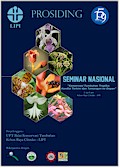| Paper |
 |
|
| Title | Pengelolaan Lanskap Multifungsi: Pendekatan Alternatif Dalam Konservasi Tumbuhan Kayu | | Author | Subekti Rahayu, Harti Ningsih, Sonya Dewi, Agus Priyono Kartono and Agus Hikmat | | Year | 2011 | | Parent Title | Prosiding Seminar Nasional “Konservasi Tumbuhan Tropika: Kondisi Terkini dan Tantangan ke Depan” | | Publisher | UPT Balai Konservasi Tumbuhan Kebun Raya Cibodas | | City of Publication | Cibodas, Indonesia | | Pages | 411-422 | | Call Number | PP0315-12 | | Keywords | landscape mosaic, rubber agroforestry, Jambi, tree species |
|
| Abstract: |
| Forest conversion to monoculture systems has caused the disappearance of 95%, leading to the absence of
the natural timber regeneration due to intensive management practices, particularly through weeding
activities. Yet, 45% (100 species) of forest timber species could only grow up to sapling stage, i.e did not
survive to higher level grows. The species composition had significantly changed, from forest species to
pioneer species. On the other hand, keeping secondary grows after fire event and practicing agroforestry
systems would enable to maintain approximately 51% (32 species) of forest species vegetation. The results
showed that by integrating land use systems (comprising monoculture plantation, secondary forest and
agroforestry system as a mosaic landscape) enabled to conserve at least 222 timber sapling species, 73 pole
species and 63 tree species through maintaining seed availability, allocating sites for species to regenerate,
and providing corridors for animals and seed dispersers to pass by. All timber species within 24 plots of 20
m x 100 m across Lubuk Beringin village (Bungo District, Jambi Province) covering remnant forest in
protected forest, rubber agroforest of 60 years old, secondary forest of 30 and 10 years old and rubber
monoculture of 30 years and 13 years old had been identified consisting of tree stage (more than 30 cm in
diameter), pole stage (5-30 cm in diameter using 5 m x 40 m), sapling stage (less than 5 cm and more than
30 cm in height using 1 m x 4 m plots). Species identification was conducted at the Herbarium Bogoriense,
Bogor. |
|